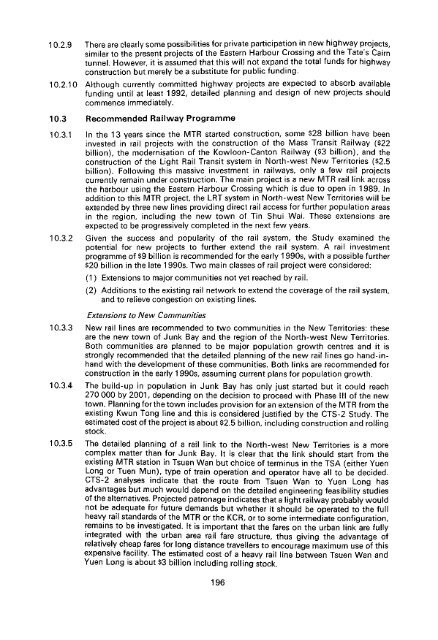Untitled - HKU Libraries - The University of Hong Kong
Untitled - HKU Libraries - The University of Hong Kong
Untitled - HKU Libraries - The University of Hong Kong
- No tags were found...
You also want an ePaper? Increase the reach of your titles
YUMPU automatically turns print PDFs into web optimized ePapers that Google loves.
10.2.9 <strong>The</strong>re are clearly some possibilities for private participation in new highway projects,similar to the present projects <strong>of</strong> the Eastern Harbour Crossing and the Tate's Cairntunnel. However, it is assumed that this will not expand the total funds for highwayconstruction but merely be a substitute for public funding.10.2.10 Although currently committed highway projects are expected to absorb availablefunding until at least 1992, detailed planning and design <strong>of</strong> new projects shouldcommence immediately.10.3 Recommended Railway Programme10.3.1 In the 13 years since the MTR started construction, some $28 billion have beeninvested in rail projects with the construction <strong>of</strong> the Mass Transit Railway ($22billion), the modernisation <strong>of</strong> the Kowloon-Canton Railway ($3 billion), and theconstruction <strong>of</strong> the Light Rail Transit system in North-west New Territories ($2.5billion). Following this massive investment in railways, only a few rail projectscurrently remain under construction. <strong>The</strong> main project is a new MTR rail link acrossthe harbour using the Eastern Harbour Crossing which is due to open in 1989. Inaddition to this MTR project, the LRT system in North-west New Territories will beextended by three new lines providing direct rail access for further population areasin the region, including the new town <strong>of</strong> Tin Shui Was. <strong>The</strong>se extensions areexpected to be progressively completed in the next few years.10.3.2 Given the success and popularity <strong>of</strong> the rail system, the Study examined thepotential for new projects to further extend the rail system. A rail investmentprogramme <strong>of</strong> $9 billion is recommended for the early 1990s, with a possible further$20 billion in the late 1990s. Two main classes <strong>of</strong> rail project were considered:(1) Extensions to major communities not yet reached by rail.(2) Additions to the existing rail network to extend the coverage <strong>of</strong> the rail system,and to relieve congestion on existing lines.Extensions to New Communities10.3.3 New rail lines are recommended to two communities in the New Territories: theseare the new town <strong>of</strong> Junk Bay and the region <strong>of</strong> the North-west New Territories.Both communities are planned to be major population growth centres and it isstrongly recommended that the detailed planning <strong>of</strong> the new rail lines go hand-snhandwith the development <strong>of</strong> these communities. Both links are recommended forconstruction in the early 1990s, assuming current plans for population growth.10.3.4 <strong>The</strong> build-up in population in Junk Bay has only just started but it could reach270000 by 2001, depending on the decision to proceed with Phase III <strong>of</strong> the newtown. Planning for the town includes provision for an extension <strong>of</strong> the MTR from theexisting Kwun Tong line and this is considered justified by the CTS-2 Study. <strong>The</strong>estimated cost <strong>of</strong> the project is about $2.5 billion, including construction and rollingstock.10.3.5 <strong>The</strong> detailed planning <strong>of</strong> a rail link to the North-west New Territories is a morecomplex matter than for Junk Bay. It is clear that the link should start from theexisting MTR station in Tsuen Wan but choice <strong>of</strong> terminus in the TSA (either YuenLong or Tuen Mun), type <strong>of</strong> train operation and operator have all to be decided.CTS-2 analyses indicate that the route from Tsuen Wan to Yuen Long hasadvantages but much would depend on the detailed engineering feasibility studies<strong>of</strong> the alternatives. Projected patronage indicates that a light railway probably wouldnot be adequate for future demands but whether it should be operated to the fullheavy rail standards <strong>of</strong> the MTR or the KCR, or to some intermediate configuration,remains to be investigated. It is important that the fares on the urban link are fullyintegrated with the urban area rail fare structure, thus giving the advantage <strong>of</strong>relatively cheap fares for long distance travellers to encourage maximum use <strong>of</strong> thisexpensive facility. <strong>The</strong> estimated cost <strong>of</strong> a heavy rail line between Tsuen Wan andYuen Long is about $3 billion including rolling stock.196
















